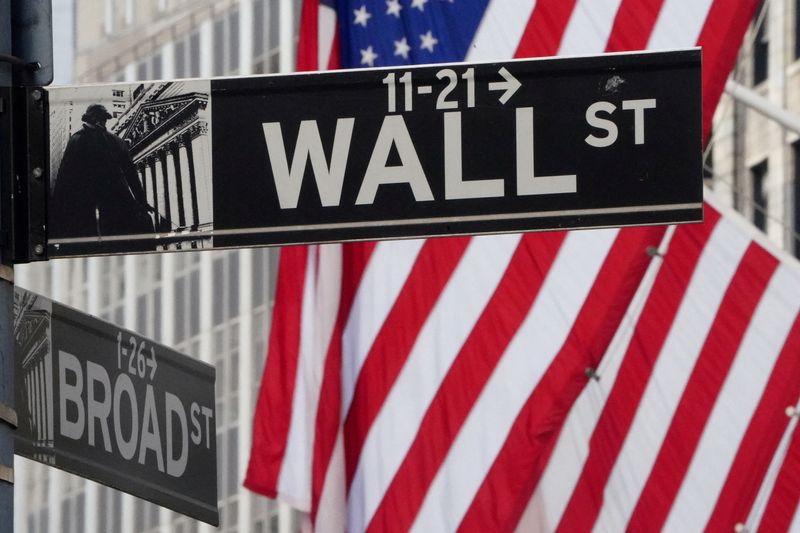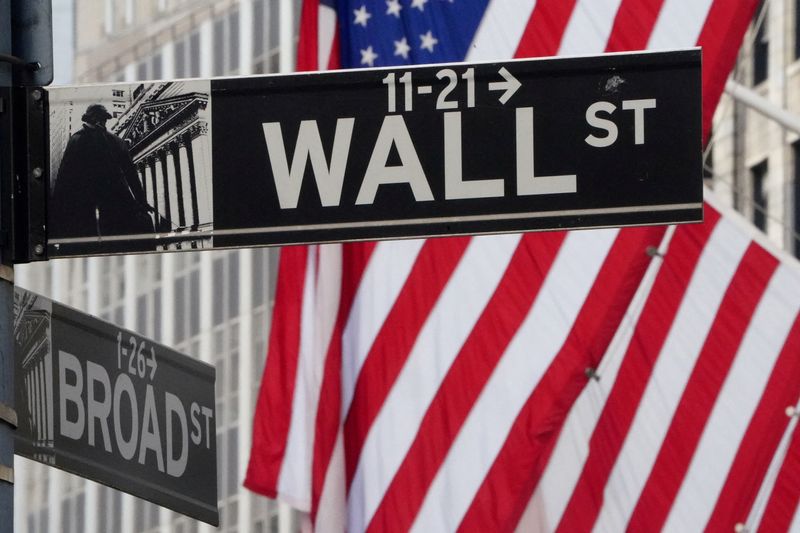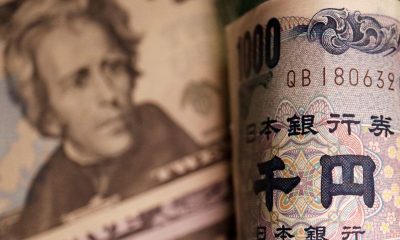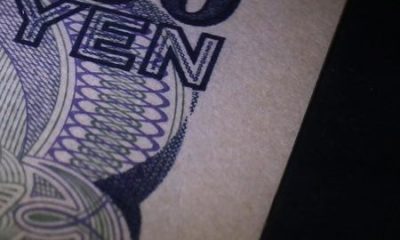Economy
Analysis-Markets outpace central banks as rate cut bets fuel ‘everything rally’


© Reuters. FILE PHOTO: The Wall Street sign is pictured at the New York Stock exchange (NYSE) in the Manhattan borough of New York City, New York, U.S., March 9, 2020. REUTERS/Carlo Allegri//File Photo
By Naomi Rovnick and Yoruk Bahceli
LONDON (Reuters) – Markets have raced ahead of the U.S., euro zone and UK central banks to price in sizeable and frenetic interest rate cuts next year, fueling a so-called everything rally that could now be vulnerable to a correction.
The U.S. Federal Reserve on Wednesday signaled it would cut rates more than previously outlined, sending global stocks and bond prices surging as markets priced in six quarter-point rate cuts in 2024, double the number projected by Fed officials.
The exuberance rushed over the Atlantic even as the Bank of England and the European Central Bank, holding borrowing costs steady, pledged on Thursday to keep monetary conditions restrictive as long as necessary.
European stocks hit their highest in almost two years after Wall Street stocks neared a record high the day before. The benchmark dipped below 4% for the first time since August, while German Bund yields hit nine-month lows.
The European moves were dominated by “market pricing in the U.S., which is quite eye-popping,” said Chris Jeffrey, head of rates and inflation strategy at Legal & General Investment Management.
“We struggle to work out what kind of world we’re in where you have 150 basis points of cuts in the U.S. next year without a recession,” he added, explaining that while LGIM was positive on government debt it was “not chasing the rally.”
Economists polled by Reuters expect the world’s largest economy to grow by 1.2% next year.
INFLATION CHEER
While rate cut pricing was pared back slightly after the ECB and BoE meetings, the scale of the cuts priced in remains significant, with investors cheered by signs inflation is falling fast.
Euro zone inflation tumbled more than expected to 2.4% in November, while in Britain it slowed to 4.6% in October, also lower than expected.
ECB president Christine Lagarde said “underlying” price pressures were moderating more than the ECB expected.
Traders now expect the central bank to lower its deposit rate from 4% to about 2.5% by next December, having added more than a 50% chance of an additional rate cut since Thursday.
They anticipate roughly 110 bps of UK rate cuts next year, more than before the Fed and even as the BoE cautioned rates — at a 15-year high of 5.5% — would stay restrictive.
The level of rate cuts now priced for the ECB reflected a “very very gloomy” economic and inflation outlook, said Danske Bank chief analyst Piet Christiansen.
“It seems quite an economic crisis scenario where you need to cut 150 basis points in one year,” he said, adding the risk is for government bonds to sell-off.
Rabobank warned that financial conditions had now eased “in such a rapid and significant way” that they could push economic growth and inflation higher, making central banks reluctant to cut rates.
Germany’s rate-sensitive two-year bond yield, touched 2.458%, on Thursday, its lowest since March. UK two-year gilt yields, at around 4.32%, were set for its biggest weekly drop since March.
RALLY ON
Meanwhile riskier European assets also rallied, suggesting investors in equities and high yield bonds were not concerned about the economic outlook.
European bank stocks, which are sensitive to worries about companies defaulting on debt, rose 0.8% on Thursday.
The cost of insuring exposure to debt defaults by junk-rated European borrowers dropped to its lowest since March 2022.
High yield debt, in general, was “pricing a high degree of the best case economic outcome,” Tom Ross, global head of high yield at fund manager Janus Henderson, said.
UK assets meanwhile also reflected a divergence of economic outlooks.
Britain’s economy unexpectedly shrank in October, data on Wednesday showed, in a boost for gilts.
Nonetheless, sterling also strengthened against the dollar on Thursday, gaining 0.9% to $1.2731. Retailers listed on {{27|Britain’s FT rose 2.75%.
For now, markets were simply rising in a burst of relief that a rapid rise in global inflation since late 2021 was going into reverse, investors said.
“The market is looking at the real economic numbers and they see inflation coming down and the potential for lower rates,” said Gerard Fitzpatrick, head of fixed income at Russell Investments, speaking ahead of the Fed’s Wednesday meeting.
“Investors are likely to paint a lot of this in a similar broad brush that inflation was a global story… and it’s sort of receding as a global story.”
Markets believed that “central banks as a whole are in roughly similar places,” added Moyeen Islam, fixed income strategist at Barclays.
“Their near term paths are probably coalescing and converging.”
Economy
Russian central bank says it needs months to make sure CPI falling before rate cuts -RBC


© Reuters. Russian Central Bank Governor Elvira Nabiullina attends a news conference in Moscow, Russia June 14, 2019. REUTERS/Shamil Zhumatov/File Photo
MOSCOW (Reuters) – Russia’s central bank will need two to three months to make sure that inflation is steadily declining before taking any decision on interest rate cuts, the bank’s governor Elvira Nabiullina told RBC media on Sunday.
The central bank raised its key interest rate by 100 basis points to 16% earlier in December, hiking for the fifth consecutive meeting in response to stubborn inflation, and suggested that its tightening cycle was nearly over.
Nabiullina said it was not yet clear when exactly the regulator would start cutting rates, however.
“We really need to make sure that inflation is steadily decreasing, that these are not one-off factors that can affect the rate of price growth in a particular month,” she said.
Nabiullina said the bank was taking into account a wide range of indicators but primarily those that “characterize the stability of inflation”.
“This will take two or three months or more – it depends on how much the wide range of indicators that characterize sustainable inflation declines,” she said.
The bank will next convene to set its benchmark rate on Feb. 16.
The governor also said the bank should have started monetary policy tightening earlier than in July, when it embarked on the rate-hiking cycle.
Economy
China identifies second set of projects in $140 billion spending plan


© Reuters. FILE PHOTO: Workers walk past an under-construction area with completed office towers in the background, in Shenzhen’s Qianhai new district, Guangdong province, China August 25, 2023. REUTERS/David Kirton/File Photo
SHANGHAI (Reuters) – China’s top planning body said on Saturday it had identified a second batch of public investment projects, including flood control and disaster relief programmes, under a bond issuance and investment plan announced in October to boost the economy.
With the latest tranche, China has now earmarked more than 800 billion yuan of its 1 trillion yuan ($140 billion) in additional government bond issuance in the fourth quarter, as it focuses on fiscal steps to shore up the flagging economy.
The National Development and Reform Commission (NDRC) said in a statement on Saturday it had identified 9,600 projects with planned investment of more than 560 billion yuan.
China’s economy, the world’s second largest, is struggling to regain its footing post-COVID-19 as policymakers grapple with tepid consumer demand, weak exports, falling foreign investment and a deepening real estate crisis.
The 1 trillion yuan in additional bond issuance will widen China’s 2023 budget deficit ratio to around 3.8 percent from 3 percent, the state-run Xinhua news agency has said.
“Construction of the projects will improve China’s flood control system, emergency response mechanism and disaster relief capabilities, and better protect people’s lives and property, so it is very significant,” the NDRC said.
The agency said it will coordinate with other government bodies to make sure that funds are allocated speedily for investment and that high standards of quality are maintained in project construction.
($1 = 7.1315 renminbi)
Economy
Russian central bank says it needs months to make sure CPI falling before rate cuts -RBC


© Reuters. Russian Central Bank Governor Elvira Nabiullina attends a news conference in Moscow, Russia June 14, 2019. REUTERS/Shamil Zhumatov/File Photo
MOSCOW (Reuters) – Russia’s central bank will need two to three months to make sure that inflation is steadily declining before taking any decision on interest rate cuts, the bank’s governor Elvira Nabiullina told RBC media on Sunday.
The central bank raised its key interest rate by 100 basis points to 16% earlier in December, hiking for the fifth consecutive meeting in response to stubborn inflation, and suggested that its tightening cycle was nearly over.
Nabiullina said it was not yet clear when exactly the regulator would start cutting rates, however.
“We really need to make sure that inflation is steadily decreasing, that these are not one-off factors that can affect the rate of price growth in a particular month,” she said.
Nabiullina said the bank was taking into account a wide range of indicators but primarily those that “characterize the stability of inflation”.
“This will take two or three months or more – it depends on how much the wide range of indicators that characterize sustainable inflation declines,” she said.
The bank will next convene to set its benchmark rate on Feb. 16.
The governor also said the bank should have started monetary policy tightening earlier than in July, when it embarked on the rate-hiking cycle.

 Forex2 years ago
Forex2 years agoForex Today: the dollar is gaining strength amid gloomy sentiment at the start of the Fed’s week

 Forex2 years ago
Forex2 years agoHow is the Australian dollar doing today?

 Forex1 year ago
Forex1 year agoUnbiased review of Pocket Option broker

 Forex2 years ago
Forex2 years agoDollar to pound sterling exchange rate today: Pound plummeted to its lowest since 1985

 Cryptocurrency2 years ago
Cryptocurrency2 years agoWhat happened in the crypto market – current events today

 World2 years ago
World2 years agoWhy are modern video games an art form?

 Stock Markets2 years ago
Stock Markets2 years agoMorgan Stanley: bear market rally to continue

 Economy2 years ago
Economy2 years agoCrude oil tankers double in price due to EU anti-Russian sanctions

































